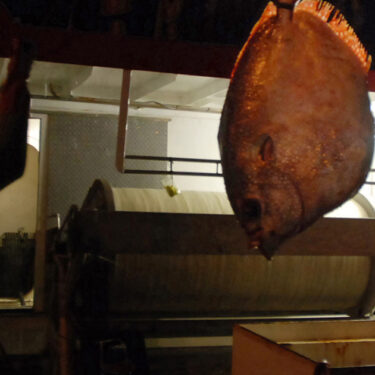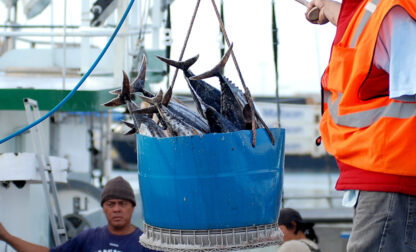HONOLULU — Pier 17 doesn’t even show up on most Honolulu maps. Cars whiz past it on their way to Waikiki’s famous white sand beaches. Yet few locals, let alone passing tourists, are aware that just behind a guarded gate, another world exists: foreign fishermen confined to American boats for years at a time.
Hundreds of undocumented men are employed in this unique U.S. fishing fleet, due to a federal loophole that allows them to work but exempts them from most basic labor protections. Many come from impoverished Southeast Asian and Pacific nations to take the dangerous jobs, which can pay as little as 70 cents an hour.
With no legal standing on U.S. soil, the men are at the mercy of their American captains on American-flagged, American-owned vessels, catching prized swordfish and ahi tuna. Since they don’t have visas, they are not allowed to set foot on shore. The entire system, which contradicts other state and federal laws, operates with the blessing of high-ranking U.S. lawmakers and officials, an Associated Press investigation found.
The fleet of around 140 boats docks about once every three weeks, occasionally at ports along the West Coast, including Fisherman’s Wharf in San Francisco, but mainly at Piers 17 and 38 in Honolulu. Their catch ends up at restaurants and premium seafood counters across the country, from Whole Foods to Costco, and is touted by celebrity chefs such as Roy Yamaguchi and Masaharu Morimoto.
Americans buying Hawaiian seafood are almost certainly eating fish caught by one of these workers, who account for nearly all the fleet’s crew.
A single yellowfin tuna can fetch more than $1,000, and vendors market the catch as “sustainable seafood produced by Hawaii’s hard-working fishermen.”
But workers such as Indonesian Syamsul Maarif aren’t protected or compensated like locals. He was sent home to Indonesia after nearly dying when his boat sank 160 miles off Hawaii. He lost everything, and said it took four months to get his pay.
“We want the same standards as the other workers in America, but we are just small people working there based on the contract that we signed,” he said. “We don’t have any visa. We are illegal, so we cannot demand more.”
Over six months, the AP obtained confidential contracts, reviewed dozens of business records and interviewed boat owners, brokers and more than 50 fishermen in Hawaii, Indonesia and San Francisco. The investigation found men living in squalor on some boats, forced to use buckets instead of toilets, suffering running sores from bed bugs and sometimes lacking sufficient food. It also revealed instances of human trafficking.
This report is part of the AP’s ongoing global look at labor abuses in the fishing industry, stretching from Southeast Asia to America’s own waters. Last year, the AP reported on fishermen locked in a cage and others buried under fake names on the remote Indonesian island village of Benjina . Their catch was traced to the United States, leading to more than 2,000 slaves being freed. But thousands more remain trapped worldwide in a murky industry where work takes place far from shore and often without oversight.
In Hawaii, federal contractors paid to monitor catches said they are troubled by what they’ve seen while living weeks at a time at sea with the men.
“You get that sort of feeling that it’s like gaming the system,” said Forest O’Neill, who coordinates the boat observers in Honolulu. “It’s a shock. It becomes normal, but it’s like, ‘How is this even legal? How is this possible?’ … They are like floating prisons.”
The investigation found men living in squalor on some boats, forced to use buckets instead of toilets, suffering running sores from bed bugs and sometimes lacking sufficient food.
“THEY’RE TECHNICALLY NOT HERE”
Under the law, U.S. citizens must make up 75 percent of the crew on most commercial fishing vessels in America. But influential lawmakers, including the late Hawaii Sen. Daniel Inouye, pushed for a loophole to support one of the state’s biggest industries. It exempted commercial fishing boat owners from federal rules enforced almost everywhere else.
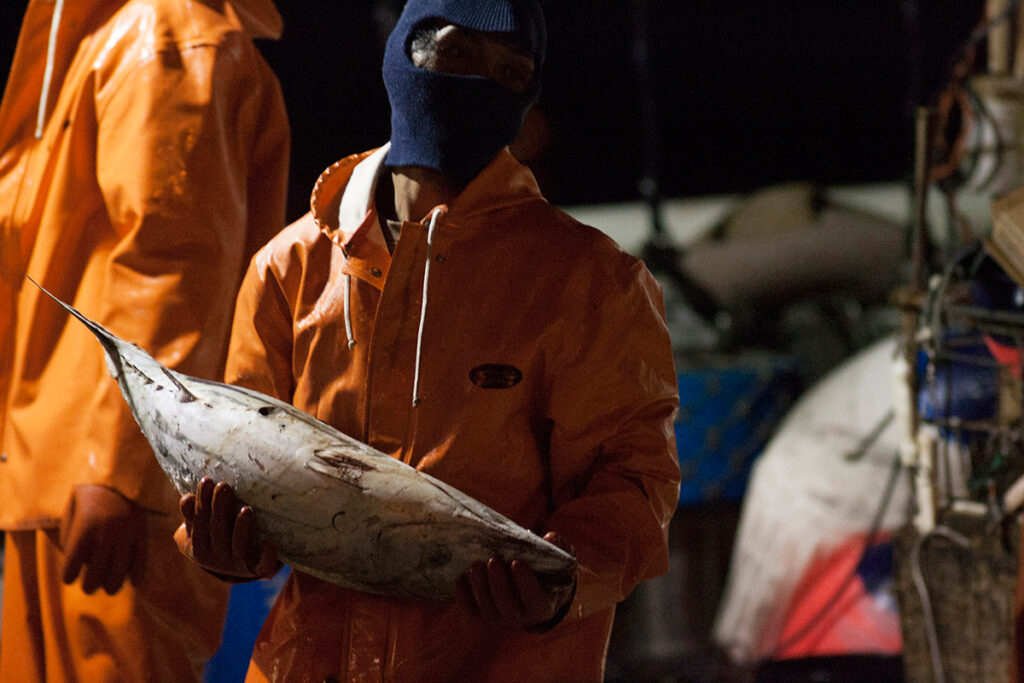
Thus about 700 foreign workers in Hawaii, who catch $110 million worth of seafood annually, lack certain labor rights most Americans take for granted. They have little legal recourse in these areas, and are detained on boats where U.S. Customs and Border Protection requires captains to hold the men’s passports. That potentially goes against federal human trafficking laws saying bosses who possess workers’ identification documents can face up to five years in prison.
U.S. Attorney Florence Nakakuni, the chief federal law enforcement official in Hawaii, said it’s all above board.
“People say … they’re like captives,” she said. “But they don’t have visas, so they can’t leave their boat, really.”
Federal laws and rules don’t mention the Hawaiian fleet by name. However, when specific details are combined, it’s clear the language in the loophole applies to these boats.
“It has the fig leaf of legality,” said Cornell University law professor Stephen Yale-Loehr, who, like other leading immigration experts contacted by AP, was unfamiliar with Hawaii’s arrangement. “This is inconsistent with the general notion in American values, if not law, that workers should be paid a fair wage and not be mistreated.”
Hawaii’s fishing industry is otherwise one of the most tightly regulated for catch limits and sustainability, attracting companies that pride themselves on being ocean-friendly. Supermarkets, restaurants and chefs selling the seafood condemned labor abuse.
President Barack Obama’s recently expanded protections in Hawaii created the world’s largest marine preserve but didn’t address working conditions. Honolulu’s fleet gets only about 10 percent of its catch from the entire restricted area.
U.S. Customs and Border Protection and the Coast Guard routinely inspect the Hawaiian boats. At times, fishermen complain they’re not getting paid and officers say they tell owners to honor the contracts. But neither agency has any authority over actual wages.
“This is a unique situation,” said Coast Guard vessel examiner Charles Medlicott. “But it is legal.”
Here’s how it works: When boat owners need crew, they pay brokers abroad or in Honolulu to bring the men from overseas — mostly from Indonesia, the Philippines, Vietnam and the tiny Pacific island nation of Kiribati. It can take weeks to coordinate, sign contracts, buy airline tickets and arrange travel documents for each fisherman.
Workers typically sign two- or three-year renewable contracts, and some extend repeatedly, staying up to a decade on boats with five to six men each.
“For one crew, one person, it’s about $10,000,” said Honolulu-based agent Hernan Santiago, who works on commission. He also wires money home to the fishermen’s families, gets them phone cards and assists in times of crisis. “I’m playing the middle man.”
“This is a unique situation,” said Coast Guard vessel examiner Charles Medlicott. “But it is legal.”
Regional Customs director Brian Humphrey said his agency could issue the workers temporary permits allowing them to enter the U.S., similar to those sometimes used by cruise ships employees. But he added that option would be “administratively cumbersome.” And so these crew members aren’t even allowed to land at the airport in Honolulu.
“There really is no purpose for them to come to the U.S. or for them to have a visa because they really don’t have any intention of setting foot on shore,” Humphrey said.
As a result, the men are first put on planes at home, and then hopscotched from country to country across thousands of miles. A typical route could go from Indonesia to Australia to Fiji to Western Samoa to American Samoa. Some pass through Amsterdam. Others end up in Mexico or Panama. They’re then picked up by American captains for the 10- to 20-day sail to Honolulu.
Some fishermen have even been made to leap into the sea. In one video shown to AP, men swam from one boat to another through tossing waves, clutching their belongings in plastic bags.
It used to be easier. Before Sept. 11, the men came on planes. But the terror attacks spurred a national crackdown on foreigners entering the country. As an unintended consequence, the workers now reach U.S. docks with minimal government vetting, creating greater security risks.
“We’ve been stuck in this hellhole,” said Jim Cook, a longtime leader in the commercial fishery who co-owns several vessels, a supply store and a seafood restaurant at Pier 38. “It’s a very complicated system that doesn’t work well for anybody, not the boat owner, not Customs and Border Protection. And the potential for mischief is far greater.”
The fishermen are paid as little as $350 a month, far below U.S. minimum wage, but still more than they can make back home in countries where people live on less than a dollar a day. Many workers also get small bonuses, lifting their monthly pay to $500 or $600. A lucky few get a percentage of the catch, making it possible to triple their wages. They’re willing to give up their freedom of movement for these jobs because of the salary.
For many boat owners, the fishermen are a bargain: Bait and ice can cost more than crew salaries. Some of the foreign workers in Hawaii earn less than $5,000 for a full year. By contrast, the average pay for an American deckhand nationwide last year was $28,000, sometimes for jobs that last just a few months, according to government statistics. Experienced American crew members working in Alaska can make up to $80,000 a year.
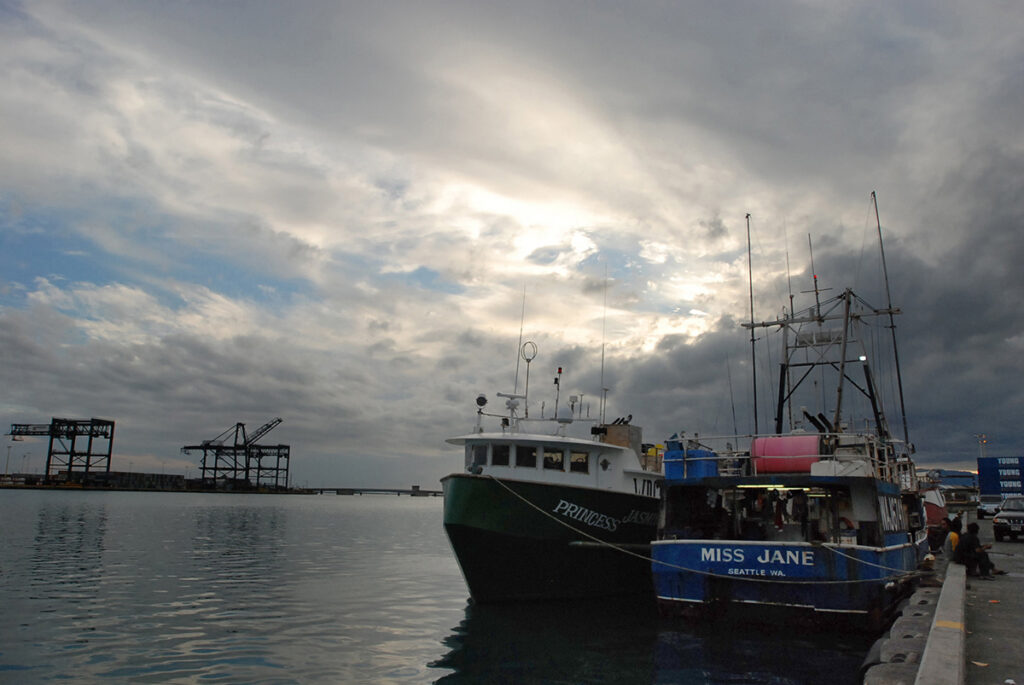
Owner Quan Do, who brings his workers from Vietnam, said profits depend on the catch. It costs $35,000 just to head out to sea. If the fish are biting, he can double his money.
“Fishing, it’s a gamble,” he said, loading groceries onto the Lady Jackie docked at Pier 17. “If you’re lucky, you win. If you’re not, you lose.”
The former refugee is one of many Vietnamese-Americans who sailed from the Gulf of Mexico to Hawaii’s rich Pacific waters in the 1980s, tripling the state’s commercial fleet. A decade later, owners found themselves short on local crew and turned to overseas workers as a solution.
In the Gulf, foreign laborers also are fishing on oyster, shrimp and menhaden vessels. But unlike in Hawaii, they’re allowed on shore, and some get paid $14 an hour for eight-hour shifts. In addition, boat owners must file for costly permits certifying no U.S. citizens are available to work.
Over the years, environmental and labor advocates in Honolulu have complained that in a state with high unemployment, the foreign workers take away U.S. jobs. However, few in Hawaii are lining up for the grueling work, weeks at sea and low pay.
Sen. Mazie Hirono, D-Hawaii, acknowledges the fishermen’s liberties are limited and has unsuccessfully proposed an amendment that would allow them to fly into the country. It’s a move that would fix a widely accepted paradox. Currently, even though the men never legally enter the United States, the government provides a transit visa that lets them exit through Honolulu’s airport.
AP reporters watched as two fishermen from Kiribati prepared to fly out. They weren’t allowed to touch their passports, which were handed to a contracted driver in a black SUV. They would not be paid until arriving home.
Bill Paupe said he’s alerted at the Kiribati Consulate in Honolulu every time a worker leaves, but he’s otherwise not involved: “They’re technically not here.”
“WHERE DID THIS FISH COME FROM?”
The fishermen are not just cheap, they’re skilled. Many from traditional Indonesian fishing villages, like Pemalang on the central coast of Java, start going to sea as young boys with their fathers. It’s a place where the glittering ocean serves as a backdrop, and laughing children set off firecrackers on a path too narrow for cars. Money sent here from fishermen around the world pays for the brightly painted cement houses and new motorbikes parked outside.
“I was jealous of my neighbors who returned from Hawaii … they were able to have a nice house and a prosperous family. So I decided to get a fishing job here,” he said. “It turns out that the salary I got is not much better than my job in my homeland. How can I have a house when I’m back home? It’s just my silly dream.”
If the men are unhappy, some are allowed to skip out on their contracts, but the ticket home can cost up to two months’ salary. They also may have to pay back recruiters’ fees, ending up trapped by debt.
In one particularly bad situation, a Kiribati fisherman’s ledger obtained by AP shows deductions from his pay including $1,300 for airfare, $1,800 to pay for his replacement and $2,100 for breaking a captain’s computer. After more than three years of work, at $350 a month, he should have accumulated close to $13,000, but he ended up with about half of that.
The U.S. government defines forced labor and debt bondage, often involving migrant workers, as modern-day slavery. Every year, the U.S. blacklists countries that have the worst human trafficking records.
“Most of the fish caught and sold in Hawaii is done by the use of exploiting migrant workers in what looks to be a human trafficking scheme legitimized by our own laws,” said Kathryn Xian, who runs the nonprofit Pacific Alliance to Stop Slavery.
Authorities are aware Hawaii’s fishermen are vulnerable to exploitation. Signs posted at Pier 17 in six languages offer a hotline to help those who have been trafficked.
That’s what happened to Abdul Fatah and Sorihin, who arrived from Indonesia seven years ago and were put on the Sea Queen II.
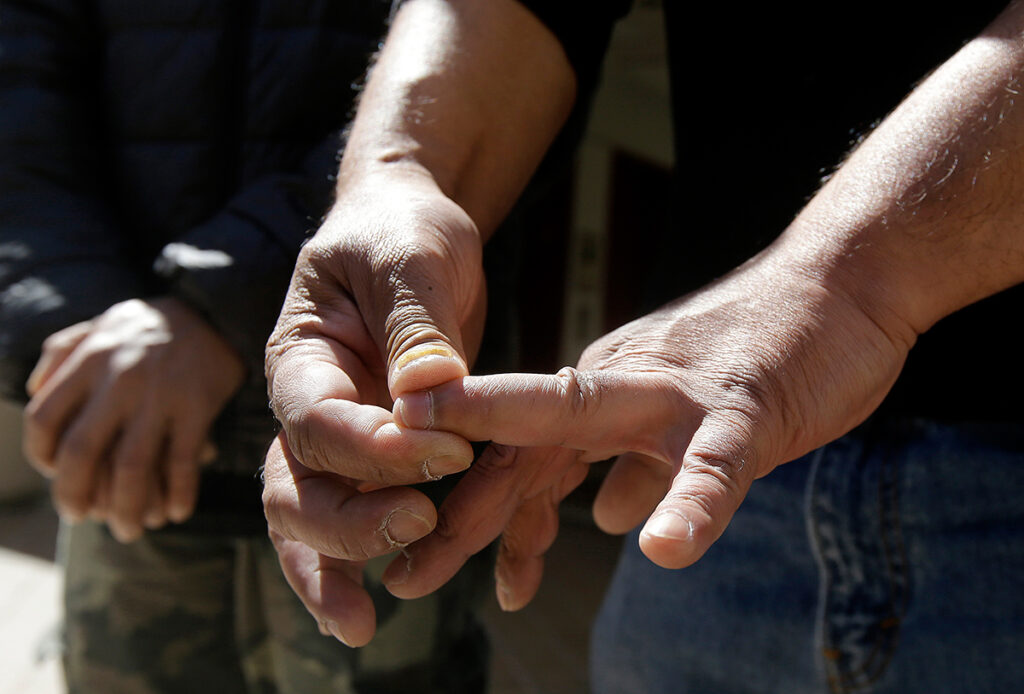
First, a fishing line nearly ripped Sorihin’s finger off, and his captain set it straight with a chopstick. Then a winch cable snapped, badly bruising the fisherman’s shoulder. That time, he said, he was allowed a two-hour rest.
“I knew if I stayed on that boat I was going to die,” said Sorihin, who uses one name.
His friend Fatah, who was kicked awake before dawn for work, was just as scared. He was thrown against a rail and nearly tossed overboard by a wave.
So early one morning when their captain was gone, the two men broke into the skipper’s quarters, grabbed their passports and made a run for it while docked in San Francisco.
“I knew if I stayed on that boat I was going to die,” said Sorihin.
Eventually, federal officials issued each of them a special visa designated for victims of human trafficking. They remain too terrified to go near the dock at Fisherman’s Wharf, where the Sea Queen II still unloads just steps away from clanging cable cars and thousands of tourists. The captain did not respond to messages left by the AP.
Sorihin has advice for American seafood lovers: “Ask, where did this fish come from? Is it the kind of fish that you got from someone in slavery?”
Not all fishing boats have harsh conditions, and some crew members said they enjoy the camaraderie. All said the experience ultimately comes down to each captain.
However, on some vessels, cultural and language barriers, coupled with exhaustion, can exacerbate tensions. Entire crews, at times, have quit. And the days can be grueling. One boat’s schedule looked like this: Work from 8 a.m. until 3 p.m., break two hours for lunch and rest. Work from 5 p.m. until 6 a.m., eat and sleep again. Start a new shift at 8 a.m.
“It’s very hard work,” said a Filipino fisherman who’s supporting a teenage daughter and a son studying engineering in college. “When the children finish school, I’m done with this.”
Crews typically spend three weeks at sea before coming into the harbor for a few days to sell their catch, restock food, repair damaged gear and fuel up. Most of the Hawaii-based fleet stays at Piers 17 and 38 in Honolulu, but some boats chase swordfish all the way to the West Coast, landing in ports including San Francisco, Los Angeles and San Diego.
American fishermen can also work exhausting 20-hour days, cramming into small bunks for respite. But when they reach shore, they go home to a bed, a hot shower and a meal. In contrast, Hawaii’s fishermen are sometimes even short on food. And unlike their American counterparts, they are dependent on their captain to bring them everything from socks and underwear to rice and meat.
“Mistreatment of workers and failure to provide for basic safety and hygiene is unacceptable. And, regardless of workplace exemptions, is illegal,” said Gavin Gibbons, spokesman for the National Fisheries Institute, which represents about 75 percent of the U.S. seafood industry.
In rare cases, boat owners can request passes from federal authorities to take the fishermen ashore for things such as medical care. Though the men are not technically allowed to leave their vessels, security guards turn a blind eye when they go onto the docks, but no farther, to see friends. One afternoon at Pier 17 in Hawaii, the foreign crews visited from boat to boat — Vietnamese cooked a shared meal, Filipinos passed around a phone, Indonesians smoked cigarettes.
One fisherman, sheltering on a boat with his buddies during a rainstorm, said the short down time they get while docked is a welcome break from the nonstop hustle at sea.
“Sometimes you don’t even have time to drink water,” he said.
At the piers, some vessels are tidy, neatly packed with coiled ropes, scrubbed rails and clean decks. Others have piles of garbage, rusting tanks and rotting carpets. On some boats, crews defecate in buckets or plastic bags, or even hang over the side of the ship to do their business.
“It’s unhealthy, quite frankly, for people to have to be kept on the boat,” said Kitty Simonds, executive director of the Honolulu-based Western Pacific Regional Fishery Management Council. “Maybe there needs to be legislation. I mean, who’s going to take that on?”
Even in the best conditions, lives are at risk.
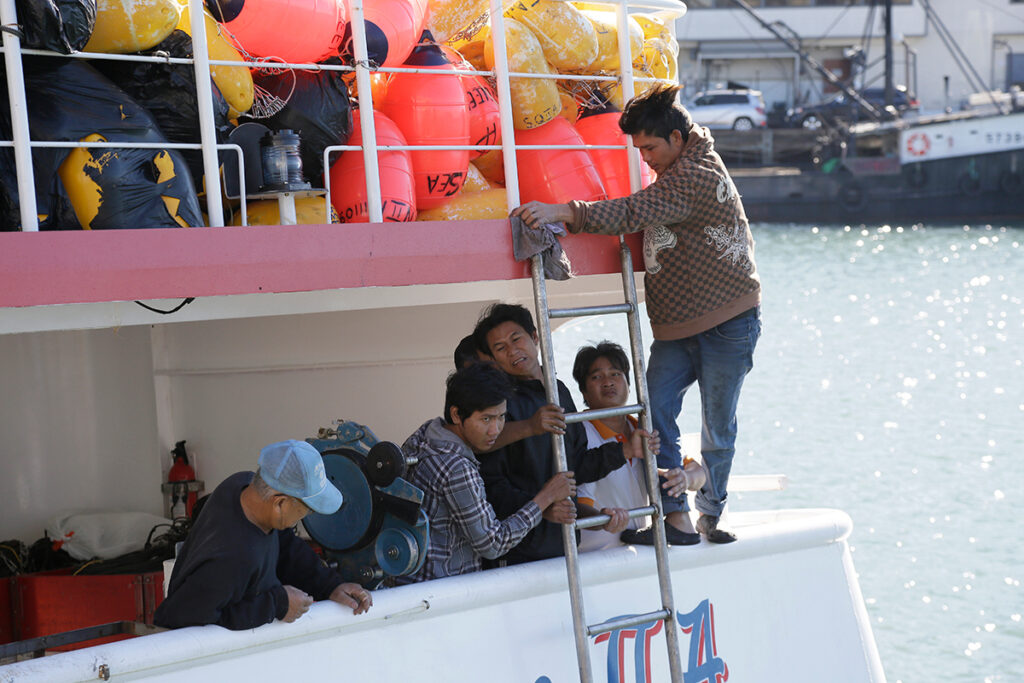
The National Institute for Occupational Safety and Health lists commercial fishing as among the most dangerous jobs in the country. In the past 10 years, five fishermen in the Hawaii fleet have died when boats sank or burned, the agency said, and at least four other workers were never found after falling overboard. Two men’s quests for better lives ended with their deaths after they were stabbed at the dock in knife fights.
Some fishermen spoke to the AP of injuries or bore scars.
After one worker began coughing up blood at sea, the Hawaii Department of Health said it was contacted by his captain, who brought him in. Doctors diagnosed the man with a rare case of active tuberculosis, isolating him for months and calling everyone on the boat in for chest X-rays and testing.
It is up to boat owners to provide care to their crews. Some fishermen said their bosses were responsive, quickly arranging medical treatment. Others complained they received inadequate care or none at all.
Dr. Craig Nakatsuka visits Pier 38 with a church outreach project that holds services twice a week, a rare opportunity for fellowship. He spoke at dusk on the dock, wearing a white coat and stethoscope.
He said he sees problems in the men ranging from high blood pressure to skin infections caused by the lack of gloves or improper gear. He’s concerned about the possibility of scurvy from a shortage of fruits and vegetables.
It’s like a “third-world overseas medical mission support in your backyard,” he said.
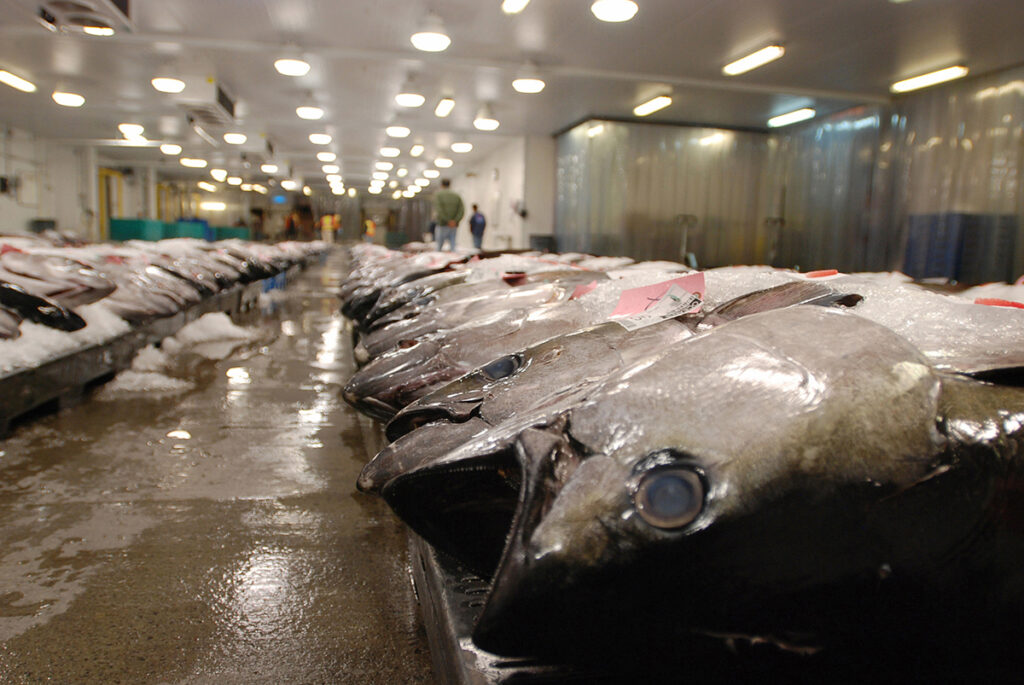
NOT SO LOCAL
At Honolulu’s Pier 38, the tired fishermen dock at the end of another trip. Some venture as far as 50 feet to a nearby public restroom, but they are careful not to stray much farther. They know they can be sent home if caught off their ships.
Just steps away at Uncle’s Fish Market & Grill, crowds dine on $20-plus plates of sashimi and ahi poke bowls, a Hawaiian staple.
The fish is unloaded early every morning at the pier and sold at the only public auction of its kind in the U.S. The sought-after seafood, famous for its taste and quality, commands prices that make the fishery the country’s fifth largest.
About 80 percent stays in Hawaii, ending up at hotels, restaurants and supermarkets, said John Kaneko, program manager for the Hawaii Seafood Council. The rest is exported, often flown fresh in airtight cool boxes to the country’s finest eateries, from Los Angeles and San Francisco to New York.
For instance, some of Roy’s 25 restaurants in eight states source seafood here. AP interviewed buyers getting fish for Whole Foods in Los Angeles, Stavis Seafood and John Nagle seafood in Boston, LaRocca Seafood in San Francisco and other popular fish markets. Delivery drivers in Honolulu were headed for a local Sam’s Club, military bases and hotels, including the Hyatt, along with supermarkets.
When asked about the workers in Honolulu, Costco said it was investigating. Wal-Mart, which owns Sam’s Club, declined to comment.
Charlie Nagle, whose family has been in the seafood industry for 130 years, said his buyers “do not and will never knowingly source from vessels that mistreat their crew.” Richard Stavis of Stavis Seafood said Thursday that his company is not currently selling fish from Hawaii.
Whole Foods spokeswoman McKinzey Crossland said only 1 percent of their seafood comes from Hawaii, and they had been assured boat crews are well paid with bonuses and health insurance. She added that the company is also looking into the issue.
During the auction at 5 a.m., John Hernandez of John’s Fresh Fish picked over rows of seafood, paying about $840 for a 100-pound bigeye tuna. It was due at New York’s New Fulton Fish Market by 11 a.m. the next day. An industry veteran, Hernandez said he knows exactly who’s working on the boats.
“The owners are a bunch of leeches making money off these crew,” he said.
Trucks loaded down with seafood from the sale fan out all over the island. At that point, the connection between the workers and their catch is lost.
“The fishermen aren’t Hawaiian?” asked Michael Pollan, a bestselling author on food and agriculture who advocates for workers’ rights. He likened the foreign fishermen’s “second-class” status in the U.S. to that of farmworkers in years past working without labor protections.
“Food produced for us in conditions approaching slavery is certainly not morally sustainable,” he said.
Across the island in an upscale neighborhood where Obama regularly vacations, an array of fish is displayed in a refrigerated case at Whole Foods, with yellowfin tuna selling for $23.99 a pound. Labels in front of each cut say: “Local matters. Fresh. Product of USA (Hawaii)/Processed in USA.”
A store worker, eager to answer questions, smiles and says it’s all caught in Hawaiian waters by local fishermen and brought to the store every morning from the auction at Pier 38.
He proudly adds: It’s the best you can buy.
Associated Press writer Niniek Karmini contributed to this report from Jakarta, Indonesia.

